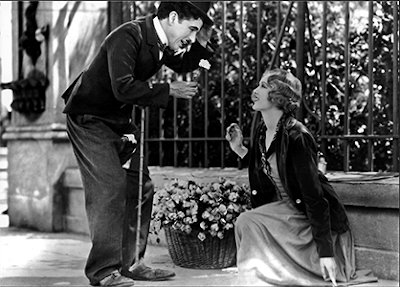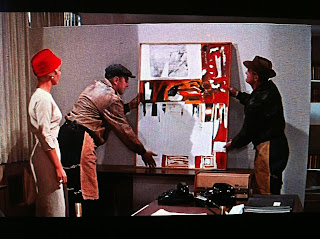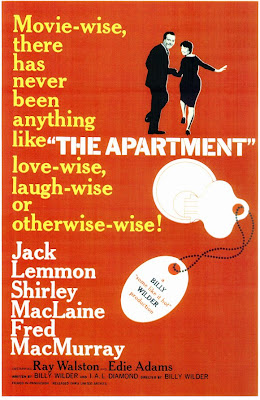30 December 2011
Films of the Year | 2011
19 December 2011
Review | The Deep Blue Sea
18 December 2011
3D. Please Die.
 |
| They look cool. |
 |
| We don't. |
 |
| Yawn. |
16 December 2011
Friday Night Watch
15 December 2011
The Future's Bright? The Future's Digital.
 |
| "Days of Heaven" |
 |
| One of the most beautiful films ever made |
 |
| "Cinema Paradiso" (1988) |
| No, this isn't a naff '90s poster. This is the future. |
30 September 2011
Review | Drive (2011)
07 July 2011
11 May 2011
Spotlight | Billy Wilder

I would like to introduce you to one of my Top 5 directors, Mr Billy Wilder.
As opposed to directors such as Orson Welles and Hitchcock who liked to bring attention to creative camera angles and editing, Wilder favoured emphasis on a sharp script and biting dialogue. He never wanted to bring attention to the actual filmmaking process, rather he wanted the audience to lose themselves in the story and characters. This no doubt stemmed from his origins in his native Germany as a screenwriter and he enjoyed a long collaboration with equally sharp-witted writer, I. A. L. Diamond.
It is his ability to “tell a good story” which is why I love him as a director. I’ve always been a firm believer in the theory that it is impossible to make a great film from a bad script (hence my hatred of anything remotely Michael Bay-like), and Billy Wilder felt the same.
Although probably best known for this:
Some Like It Hot (1959)
He is one of my best-loved directors for this:
Sunset Boulevard (1950)
And possibly my alltime favourite…
The Apartment (1960)
A few quotes burned in my brain:
“That’s the way it crumbles, cookie-wise” The Apartment
Joe Gillis: You're Norma Desmond. You used to be in silent pictures. You used to be big.
Norma Desmond: I *am* big. It's the *pictures* that got small.
Sunset Boulevard
“Real diamonds! They must be worth their weight in gold!” Some Like It Hot
“When you're in love with a married man, you shouldn't wear mascara” The Apartment
“Story of my life. I always get the fuzzy end of the lollipop.” Some Like It Hot
“There's nothing tragic about being fifty. Not unless you're trying to be twenty-five.” Sunset Boulevard
“It’s not how long it takes, it’s who’s taking you” Some Like It Hot
“I'd like to spell it out for you...only I can't spell” The Apartment
“Mr De Mille, I’m ready for my close-up” Sunset Boulevard
“Nobody’s perfect!” Some Like It Hot
Do yourself a favour and rent one of the above films this weekend. You’ll have a couple of hours of wonderful.
21 April 2011
Trailer | Tree of Life
18 April 2011
Turn on those City Lights

If he had been alive yesterday, Charlie Chaplin would have turned 122 years old.
I usually hate these pointless headlines, invented by the media for no reason other than to fill in a blank on their schedule. However, this is actually quite telling. 122 years is a long time in the entertainment world. When you think that the medium of cinema is only just over 100 years old itself, anything older seems archaic. Even in his forties, Chaplin was considered a bit of a luddite for his insistence on keeping his films silent whilst the rest of Hollywood embraced sound. He resisted for as long as he could, and in so doing, marked himself as a member of the old guard even at a relatively young age.

I fell in love with Chaplin as a child. I was the kid who spent most hot summer days inside, curtains drawn, watching back to back screenings of The Tramp and his flower girl. Like all great friendships, a relationship with Chaplin is one that evolves over the years. The adventures of "The Little Tramp" were some of my favourites from the tender age of 5 or 6. I adored the slapstick comedy, the scenes of drunk characters bumping into lamp-posts or escaping baton-wielding policemen. Show me a child who doesn't find the eating machine scene from Modern Times hilarious and I will declare them certifiably insane.
As I left childhood behind, it was the scenes of love and loss that struck a chord. I couldn't watch the final scene of City Lights without reaching for the Kleenex. There is no sound apart from the swell of sweeping strings; their mouths move, but no words come out. Instead, the emotion comes from the expression of their faces, their eyes, the way they move their hands. There is no script to prop the actors up.

Now when I watch his films, I still love the slapstick and humour, the pathos and heartbreak, but I see something fresh and new. For those who think that silent films are irrelevant and from the dinosaur-age of moviemaking, watch the factory scenes from Modern Times and think again. Chaplin's tramp stands at a production line, working so fast that he doesn't even have time to scratch his nose. If he takes a moment to swat a fly, he has lost the rhythm of his work and must work even harder to make up for lost time. Chaplin seems to be suggesting that in the world of 1936, the pace of technology is moving so fast that we can only ever play catch-up. Now, 75 years later, how many of us struggle to keep up with the constant updates to our iPads, computers and mobile phones? How many times do we take a mini break from Twitter or Facebook, only to then feel like we have a deluge of information to catch up on when we return? Like that production line, it is hard to take a break without feeling like you're falling behind. Chaplin - irrelevant? If anything, as its title suggests, Modern Times is a film for our age too.
03 March 2011
Review | The Apartment

Ever since I first saw it as a teenager, I have been in love with The Apartment (1960). Perhaps it was the opening shots of Manhattan that cemented my love, or maybe the loveable character of C.C. Baxter played by the wonderful Jack Lemmon. Possibly it came down to the pin-sharp script or the perfection of Shirley Maclaine. In hindsight, I think it was simply a blend of all of the above.

The Apartment tells the story of C.C Baxter (Jack Lemmon), an insurance man who works on the nineteenth floor for a firm based in Manhattan. He finds himself popular amongst the firm's executives for his apparent willingness to lend out his apartment for them to entertain their secretaries and mistresses. As he begins to climb up the corporate ladder, he falls in love with Fran Kubelik (Shirley Maclaine), an elevator girl who happens to be in love with one of the executives. You can imagine the rest.

The film swings between comedy and drama, dealing with serious themes for the time such as adultery and suicide (which was still illegal in 1960). It captures the monotony of office life perfectly, with the unbearable din of the typewriters and the dreary lights in the suspended office ceiling stretching to infinity behind Baxter. We understand why he is attracted to Fran, whose bright and sunny disposition is a perfect contrast to the tedium of his everyday life.

I adore this film. If a gun was put to my head and I was forced to name my all time favourite movie, The Apartment might well be it (It swings between this, The Godfather and Annie Hall). For me, great film-making is all about the script. And this film has a humdinger of a screenplay. The words bite and sink their teeth. That last line will forever be etched in my consciousness.

Watching it in 2011, it is obvious how influenced Mad Men creator, Matt Weiner is by The Apartment. From the staging of the office scenes through to the clothes, characters and what comes out of their mouths, it all has a definite hint of Draper & co. Filmmakers who channel Wilder include Sam Mendes, whose American Beauty had much to owe to this and Wilder's other gem, Sunset Boulevard. Despite some of the issues in The Apartment belonging very much in 1960, it seems that the essence of the film and its maker still shines brightly. To quote Baxter, "I guess that's the way it crumbles, cookie-wise."
10 February 2011
Spotlight | Edith Head ~ Designer Extraordinaire

It is impossible to write a blog about vintage film without spending at least one post discussing the merits of Edith Head. Even before the lead actress appears on screen, I can tell I'm in for a couple of hours of sartorial sweetness when I see "Costumes by Edith Head" appear on the opening credits.



She holds the record for being the woman with the most Oscar nominations in history ~ a staggering 35 nominations with 8 wins. Even if you've never heard of her name, you have no doubt seen and recognise several of her creations worn by Audrey Hepburn, Bette Davis and Grace Kelly to name but a few. Studios were keen for their films not to fall out of favour with passing trends, and Edith Head assisted by designing iconic costumes that were classic and timeless. Many modern brides owe their dress designs to this talented lady.

 (above left ~ talking to Hitch / above right ~ with Audrey)
(above left ~ talking to Hitch / above right ~ with Audrey)I also love her trademark black fringe/chignon and dark glasses, which she had from the 1930s until the end of her life. Like her creations, it made her timeless and almost ageless. I like my designers looking chic ~ if they're expected to make others look good, they should be stylish themselves.

A snippet of her back catalogue:
All About Eve (1951)
A Place in the Sun (1952)
Roman Holiday (1954)
Sabrina (1955)
To Catch a Thief (1956)
Funny Face (1958)


For the best example of her amazing creations, set aside three hours to watch The Ten Commandments. Technicolor knew how to make colours sing, and there are few sights more glorious than that of Anne Baxter in shades of emerald, ruby red and sapphire.

For further inspiration, you might want to buy this book. Or perhaps you want to treat me instead?

07 February 2011
Review | A Place in the Sun
 Those who know me, know that I'm a sucker for an old black and white movie. Throw in the beauty of Elizabeth Taylor and the costumes of Edith Head, and you've got the perfect Sunday afternoon, with or without the rain.
Those who know me, know that I'm a sucker for an old black and white movie. Throw in the beauty of Elizabeth Taylor and the costumes of Edith Head, and you've got the perfect Sunday afternoon, with or without the rain.A Place in the Sun tells the story of George Eastman (Montgomery Clift), a young boy from the poor side of the tracks who takes a job at his rich uncle's factory. Desperate for some warmth in his life, he starts a relationship with a fellow factory worker, simple, trusting Alice (Shelley Winters). Soon after, he starts to fall in love with the glamorous and beautiful Angela (Elizabeth Taylor), as well as developing a hankering for her family's rich and carefree way of living. Despite his best efforts, George is unable to escape Alice, who is desperate for George to marry her. As he falls further in love with Angela, George finds himself going to more extreme lengths to rid himself of his former conquest, with devastating consequences.

The film manages to blend both scenes of romance with a serious, threatening edge. Clift succeeds in making us feel sympathy for the plight of George, even when he is leading on both Alice and Angela. This is a story of the "American Dream", with George desperate to make something of himself and escape the poor of his youth. With their attitude of "anything is possible", Americans have constantly been encouraged to seek a better life for themselves, often at whatever cost. As we see in A Place in the Sun, the chasing of a better life can make us blind to the consequences our actions are creating.

Perhaps we also feel sympathy for George because of our knowledge of what befell Clift in reality. Considered a lost and troubled soul, Montgomery Clift struggled his whole life with his sexuality and died at the young age of 45 from a heart attack. His friendship with Elizabeth Taylor lasted until his death, and their scenes together demonstrate a strong, undeniable chemistry.
If it's a good black and white film you're after, look no further. Sixty years on, it's still fresh as a daisy.
03 February 2011
Memo | Favourite film? Impossible.

One of the questions I love to ask people I meet is "What's your favourite film?". It's an ice-breaker, it can lead to all kinds of new conversation, and I think it says so much about the person themselves. Unfortunately, I can never answer that question when asked of myself (which also probably reveals far too much about my personality). To name just one favourite film would be like choosing one favourite song or one favourite vintage dress; it changes with the mood or time of day. I might be feeling nostalgic and go for Gone with the Wind. Or perhaps I'm in the mood for a little pick-me-up, in which case Singin' in the Rain. The Godfather might suit my more serious frame of mind. The point is that there is no number one. They're all contenders and that's the way I like it.

 My list includes musicals, comedies, costume dramas, documentaries, biblical epics, mob movies, westerns, french new wave, P.O.W dramas, black comedies, foreign films, ballet and a mockumentary about a fake rock band. Variety is the spice of life, so they say. What I love about favourite films is that "best" doesn't come into it. I can appreciate that a favourite film might not be the most technically brilliant ~ It's how it makes me feel that's important.
My list includes musicals, comedies, costume dramas, documentaries, biblical epics, mob movies, westerns, french new wave, P.O.W dramas, black comedies, foreign films, ballet and a mockumentary about a fake rock band. Variety is the spice of life, so they say. What I love about favourite films is that "best" doesn't come into it. I can appreciate that a favourite film might not be the most technically brilliant ~ It's how it makes me feel that's important.02 February 2011
Decor Obsession | Pillow Talk

Rom-coms aren't usually my cup of tea, but I can happily make an exception for one from the 1950s that features Doris Day as well as fabulously gorgeous set decoration. 1950s and 60s design rocks my world, and although Doris Day's apartment in Pillow Talk (1959) is a little frou-frou for my tastes, I still adore the pastel colours and oversized lamps.


Love the hanging pendants...and a view of Manhattan can never be beat.

How I love abstract oil paintings. I can't resist buying them and have about five at home waiting to hang...just need to find more walls...

I have a bit of a thing for grasscloth walls.

Pink and purple - probably two of my least favourite colours, and yet they work so well with lemon yellow. I think the key is to not fear the colour clash - embrace it and let it take over every white surface.

Who can resist pastel colours and sixties split-screen?

So that's this week's decor obsession. Do these retro 50s digs turn you on or off?














